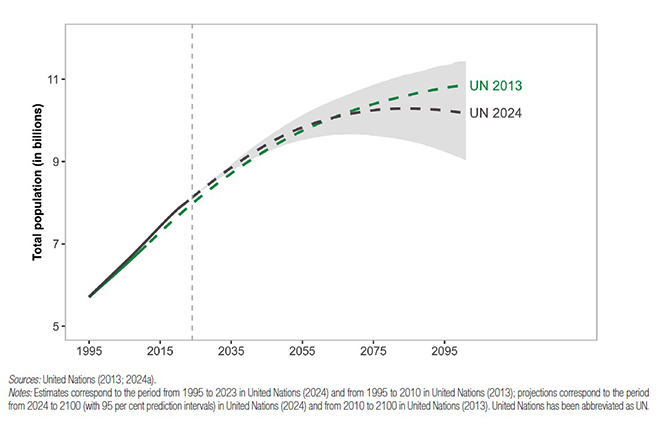Challenges, prospects for predictive research in social sciences

FILE PHOTO: Global population, according to United Nations (World Population Prospects) in 2013 and 2024, 1995–2100
Predictive research analyzes various social phenomena and data to uncover future trends and possibilities, providing a scientific basis for policymaking, strategic planning, and social governance. While traditional predictive research faces numerous challenges in terms of data, methodology, and application, the rapid advancement of data science in recent years has opened up vast new possibilities for the field.
Common challenges
Data deficiencies: First, data scarcity undermines the accuracy of predictive models. Second, the data collection process is influenced by sampling biases, survey design flaws, and data entry errors, which leads to data distortion. Third, issues with data timeliness and representativeness persist. The collection, processing, and publication of survey data often takes several years, preventing timely reflection on recent social phenomena. Additionally, big data is often sourced from specific platforms or channels, which may bias the data toward certain user groups or behavior patterns while overlooking populations that are less digitally engaged.
Methodological limitations: Many predictive models omit certain intermediate processes and variables to simplify computations and improve efficiency, weakening their explanatory power and accuracy. Furthermore, accurately identifying and incorporating all relevant variables constitutes a major challenge. For example, voter sentiment, public opinion, and unexpected events can all affect election results, but they are difficult to quantify in forecasting. In addition, due to ethical, legal, and practical constraints, strict experimental control is often impracticable in social science research, leading to biased predictions.
Application challenges: Firstly, many theoretical models are built upon specific assumptions and conditions that may not hold true in the real world. Consequently, forecast biases occur when these models are applied. Secondly, existing theoretical models are not applicable to all domains and phenomena, and often lack effective theoretical support when addressing emerging issues. Thirdly, the slow pace of theoretical model updates and iterations renders some models unsuitable for explaining new social phenomena.
Prospects
Optimized input data: Big data offers massive resources that can alleviate the problem of data scarcity. Traditional predictive methods based on theoretical assumptions and expert experience can be complemented by data-driven predictive research. The widespread adoption of the Internet of Things, the internet, and mobile devices provides predictive research with a wide range of data, while the integration of multi-source data enables an exponential leap in predictive capabilities. Moreover, next-generation communication technologies characterized by high speed and low latency, along with smarter data integration tools, allow for rapid integration, cleansing, and transformation of data from various sources.
Innovation in predictive techniques: Deep learning has revolutionized predictive research. With continuous optimization of model structures and algorithms, deep learning improves prediction accuracy, accelerates model training, and enhances model generalizability to accommodate diverse types of data and tasks. Rapid advances in multimodal data fusion technologies, which integrate image, text, audio, and sensor data, not only enable datasets to complement each other but also mitigate the limitations of single-modal data by compensating for information gaps. Additionally, quantum computing, by overcoming computational bottlenecks, may drive breakthroughs in areas such as financial risk forecasting.
Paradigm shifts in predictive research: As contemporary society becomes increasingly complex and dynamic, single-discipline research methods are no longer adequate to fully explain and predict social phenomena. Interdisciplinary research therefore serves as a key direction in the development of predictive research. Integrating predictive research with economics, political science, and psychology can provide profound insights into the causes and evolutionary patterns of social phenomena, while its collaboration with computer science, mathematics, and statistics can offer robust algorithmic support.
In the future, predictive research should further refine its data foundations and analytical methods to ensure scientific rigor, accuracy, and sustainability, thereby offering strong scientific support for social development and macro-level strategy formulation.
Sheng Yinan is a professor from the School of Labor Economics at the Capital University of Economics and Business.
Edited by WANG YOURAN

 PRINT
PRINT CLOSE
CLOSE